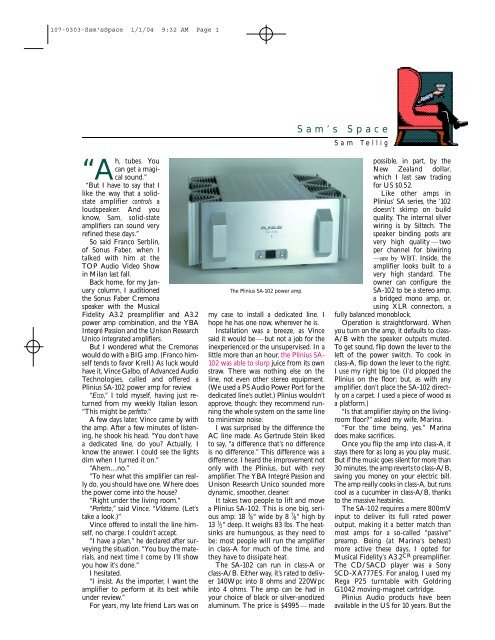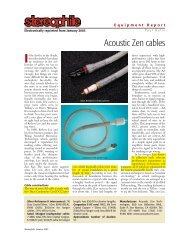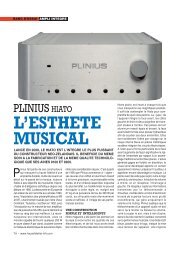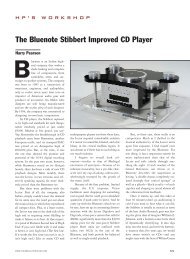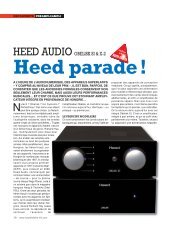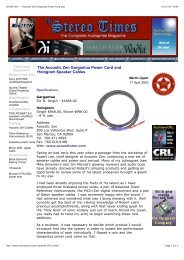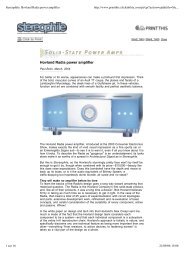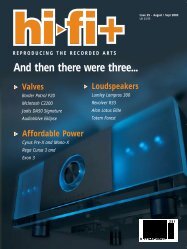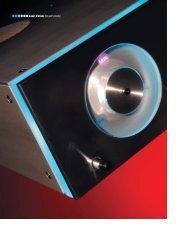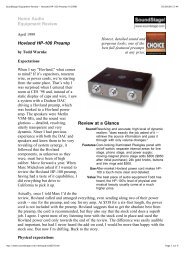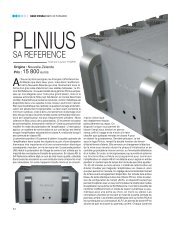Sam's Space - Jason Diffusion
Sam's Space - Jason Diffusion
Sam's Space - Jason Diffusion
- No tags were found...
You also want an ePaper? Increase the reach of your titles
YUMPU automatically turns print PDFs into web optimized ePapers that Google loves.
107-0303-<strong>Sam's</strong><strong>Space</strong> 1/1/04 9:32 AM Page 3transient silence. More defined dynamicshadings. Inner detail and authority. ”Resuming his scientific demeanor,Gary expanded on the benefits of class-A operation: “With class-A circuit topolo g y, the total current that the amplifi e ris capable of delivering is kept flow i n gin the circ u i t, re g a rdless of demand —while in a class-A/B amplifi e r, curre n tf l ow varies with demand. As curre n tv a r i e s, the voltage on the rails as seen bythe output stage varies too. This leads tothe powe r -supply modulation commonin class-A/B designs. ”H i g h -c u r rent capability is desirable inan amplifier and a major reason whym a ny audiophiles favor big solid-s t a t ea m p s. (Tube amps tend to do less we l lwhen it comes to sourcing curre n t. )Vince Galbo told me that you canalmost determine an amplifier’s curre n tcapability by its weight: the heftier thea m p, the bigger its power supply andt r a n s f o r m e r s, and the more current itcan supply.“ That’s important in musical terms, ”Vince said. “When an amplifier isn’table to keep up with current demands,voltage sags and music suffers. You canhear it when a sudden drum beat comesa l o n g. If you don’t have enough curre n t,voltage falls down and the drum beatloses its impact. ”I certainly heard the kickdru m ’ simpact on “Burning Love,” on Elvis: 30#1 hits (RCA 07863 68079-2). Otheramps in house did deliver the sameimpact as did the Plinius.If memory serves me right, the SA-50 Mk. III sounded noticeably better inclass-A than in class-A/B, where theamp seemed slightly cold or sterile byc o m p a r i s o n. The SA-102 was differe n t.I often had to look at the class-A LED(to the right of the On/Off switch) tosee whether the amplifier was in class-Aor not. Often it was working in A/B.I often doze off in the eve n i n g. By thetime I wake, the SA-102 has reverted toc l a s s - A /B. “Drat!” I declare, pulling myselfup from my listening chair.I posed the question to Gary: “Whydoes class-A/B now sound very close toc l a s s - A ? ”“It’s because we have a ve r y -l a r g e -capacity power supply,” Gary re p l i e df rom sheep country. “It’s not easily modulatedby output-stage current variations.And we still run a generous amount ofo u t p u t -stage current in class-A/B. ”So in class-A/B, the amp still operatesin class-A —at least for a few watts.Some manufacturers of big solidstateamps have gone to sliding-bias arrangementsin which class-A kicks in asneeded, the amp stays cool, electricityis conserved, and so on. I call thesethings “miracle circuits.” I asked Garyabout them.“A ny sort of sliding class-A bias — n omatter how well it is done — will have an e g a t i ve sonic impact. The scheme willcause some of the amplifier’s operatingparameters to be modulated by the signa l —exactly what most designers wantn o t to happen.“ S l i d i n g -bias schemes are usuallyused to reduce the large amount of heatgenerated in a class-A design. In thePlinius SA-102, we have enough heatsinkarea to dissipate heat without turningto compro m i s e s. ”I listened to the SA-102 for morethan a month with the Sonus FaberC remona speakers. I appreciated whatFranco Serblin meant about “contro l. ”The Plinius SA-102 took charge of thes p e a k e r s, especially the bottom end. Iasked Gary whether this control camef rom a high damping factor.“ While we achieve damping factorsof around 50 or 60 into an 8 ohm load,we don’t focus on damping factor as anoverly important parameter. Th ea m p l i fier has a massive, ve r y -l ow -impedance power supply, with highs t o red energy and high current capabilit y. The output stage has such a hugecapacity for current delivery that awoofer won’t be starve d, no matterh ow much current it needs. ”The treble was sweetly and smoothlyext e n d e d. Franco Serblin was right:s o l i d -state amplifiers h a v e become ve r yre fi ne d — some of them, any w ay. Wi t hthe Plinius-C remona combination, Ih e a rd a lovely liquidity — a total absenceof the hardness or harshness that,in the past, I’ve so often associated withs o l i d -s t a t e .T wo weeks before deadline, Re n a u dde Vergnette, of Triangle Electro a c o u s-tique, and Richard Ko h l ru s s, of VMAXS e r v i c e s, his North American importer,a r r i ved with the flagship Tr i a n g l eMagellan speakers. These will likelyretail in the US for around $35,000/p a i r. It’s fun to go hors de catégorie, as theF rench hi-fi scribes like to say. Some ofthe Magellan’s technology and magicwill trickle down to more afford a b l eTriangle models. And soon.When Renaud and Richard visited,we selected three SACDs: Berlioz’sSymphonie Fa n t a s t i q u e, with Pa avo Järviconducting the Cincinnati Symphony( Te l a rc SACD- 6 0 578); Rachmaninoff’ sPiano Concerto 3 and Scriabin É t u d eswith pianist Lang Lang, Yuri Te m i r-k a n ov, and the St. Petersburg Phil-
107-0303-<strong>Sam's</strong><strong>Space</strong> 1/1/04 9:32 AM Page 4harmonic (Te l a rc SACD-60582); andChet Baker’s C h e t (R i ve r s i d e /A n a l o g u eP roductions CAPJ 1135 SA) .We rotated the three discs, comparingthe Plinius SA-102 (with MusicalFidelity A3.2 CR p re a m p) and two integratedamps: the Unison Re s e a rc hUnico and YBA Passion Integré. Butafter they left, I had another 10 days oflistening on my own before deadline,and turned to non-audiophile material:Louis Armstrong in the 1920s and ’30s.Ditto Duke. Count Basie’s first re c o rdin g s. The Chronological Bing Crosby o nJonzo Re c o rd s. I played many of the historicalclassical CDs that Klaus Heyma n n, of Naxos, has sent me: JaschaH e i f e t z, Yehudi Menuhin, ArturS c h n a b e l.In many way s, vintage or “historical”re c o rdings present the toughest challenge.Old re c o rdings or new, thePlinius controlled the Triangles’ multiplewoofers with an iron grip. Despitetheir lack of dynamic range, many ofthese re c o rdings sounded smooth,s we e t, and mellow—not at all harsh ort h i n. Bass definition and extension we reex c e l l e n t. So was the overall re s o l u t i o n.I heard superb bottom-end control anda very swe e t, smoothly ext e n d e dmidrange and treble. The Magellans arealso capable of remarkable re s o l u t i o n,and the Plinius SA-102 did not disappo i n t. When I consider that thesespeakers retail for roughly seven timesthe amplifier’s price, the latter’s performancewas ex e m p l a r y.Someone buying an ex p e n s i ve speakerlike the Magellan might allocatem o re than $5,000 for an amplifi e r. Iwonder what two Plinius SA-10 2 smight sound like. Bridge them intomono…or since the Magellan allow s,l e ave the Plinius in stereo and simplyb i a m p, horizontally or ve r t i c a l l y. At atotal price of $10,000, two Plinius SA-102s might make an attractive pro p o s i-t i o n, possibly gaining you a moreex p a n s i ve soundstage and an eve ng reater sense of dynamic ease.Th e re’s something to be said for abig amp: it can make big sound. Th ePlinius SA-102 did this without eve rt u rning hard or harsh, without soundingraucous or losing resolution andfine detail. This amp was as free ofgrain as any solid-state amplifier I haveh e a rd at any price.Was it perfect?1 In horizontal biamping, one amp drives them i d r a n g e / t reble units, the other drives the wo o f e r s. Invertical biamping, a single amplifier drives a singles p e a k e r. You just have to feed the same signal to theinputs of both channels.Comparing the Plinius SA-102 to theYBA Integré Passion and Un i s o nRe s e a rch Un i c o, I had one slight re s e r-v a t i o n. Mind yo u, those re l a t i vely smallintegrated amps did n o t c o n t rol theMagellans’ woofers as well as the Pliniusd i d, and didn’t play as loud. When Itried cranking up the YBA Integré toPlinius leve l s, the amp blew a fuse.But I wonder whether the Pliniusmight have been a wee bit too polite.It’s not that I heard any loss of re s o l u-tion or detail — far from it. But I wantedChet Baker’s trumpet to be a bitm o re brassy, to have a bit more bite.Ditto with Pa avo Järvi’s re c o rding ofthe Symphonie Fa n t a s t i q u e. This piece cant u rn quite raucous, and Te l a rc’s re c o rdingcatches this aspect (accurately, in myv i ew). With the Plinius SA-102, I feltthat things we re being smoothed ove rs l i g h t l y, taming some of the music’sb a r k, blare, and bite. (G a d, the musicsounds like me.)I missed some of the vibrancy and lifethat I hear with great tube gear —t h a t“lit from within” quality that I especiallyassociate with single-ended triodes.I’m not sure what to call this, but Ithought that the Plinius — at least withthe Cremona and Magellan speakers —lacked some degree of harmonic immedi a c y, leaving me sometimes less thanfully engaged by the music.But how much would I have to payto get that harmonic immediacy a n d t h ePlinius’s bottom-end control? I suspect ag reat deal more than $5000.Let’s say you bought a tube amplifi e rfor roughly the same price. In the wo rd sof my colleague John Marks —a bigPlinius fan —would a tube amp “wre s-tle the woofer to the gro u n d ’ ’ ?And system matching is eve r y t h i n g.Sonus Faber speakers are all noted forh aving the company’s unique sonics i g n a t u re — n ever harsh, possibly a littlesoft in the upper midrange and treble.Triangle’s Magellan seems tomark a departure for that company,especially in the treble re g i o n, wheret h e re was a smoothness, swe e t n e s s,and re finement I had not heard beforef rom Triangle designs. Neither speakercould be called aggre s s i ve .The Plinius SA-102 may be just whatyou need to control your speakers andtame any tendency they might have towa rd aggre s s i ve n e s s. For $5000, you getsuperb performance, excellent buildq u a l i t y, and the smoothest midrangeand treble this side of tubes.And a dedicated AC line? I can imagineLars reading this column and say i n g,“I told you so. ” s


